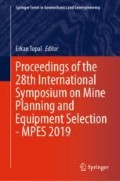Abstract
The main principle of mineral resource estimation process is to quantify a mineral grade in target places. However, in many cases, available dataset show heterotopic sampling pattern that makes the current practice of mineral resource estimation challenging. In order to cope this difficulty, one alternative consists of removing the sample locations that only one variable is available. Despite an attractive simplicity of this method, one may mention that such excluding of valuable data may lead to biased results for resource modeling. Another solution for this impediment is using imputation algorithms, for which the data at sampled location is imputed by stochastic techniques. This is beneficial not only because one can keep the co-variate data, but also the uncertainty can be quantified. In order to show the capability of the imputation method, in this study, a homotopic dataset from a limestone deposit located in south of Kazakhstan is selected as the actual case study accompanying with another homotopic dataset from Chile to evaluate the proposed approach of imputation. Then, to investigate uncertainties in data imputation process, a technique called Sequential Gaussian Co-simulation was utilized. For this purpose, homotopic dataset was transformed to heterotopic dataset. This allows performing validation of the proposed technique. Lastly, sensitivity analysis was carried out to observe the effect of amount of missing data. Overall results of imputation techniques showed satisfactory results, and it can be concluded that derived simulated grade values for drillholes can be incorporated to the ore body modeling.
Access this chapter
Tax calculation will be finalised at checkout
Purchases are for personal use only
References
Battalgazy, N., Madani, N.: Categorization of mineral resources based on different geostatistical simulation algorithms: a case study from an Iron Ore Deposit. Nat. Resour. Res. (2019)
Rossi, M.E., Deutsch, C.V.: Mineral Resource Estimation. Springer, New York (2014)
Chiles, J., Delfiner, P.: Geostatistics: Modeling Spatial Uncertainty, 2nd edn. Wiley, New York (2012)
Metahni, S., Coudert, L., Gloaguen, E., Guemiza, K., Mercier, G., Blais, J.F.: Comparison of different interpolation methods and sequential Gaussian simulation to estimate volumes of soil contaminated by As, Cr, Cu, PCP and dioxins/furans. Environ. Pollut. 252(A), 409–419 (2019)
Paravarzar, S., Emery, X., Madani, N.: Comparing sequential Gaussian and turning bands algorithms for cosimulating grades in multi-element deposits. C.R. Geosci. 347(2), 84–93 (2015)
Verly, G.W.: Sequential gaussian cosimulation: a simulation method integrating several types of information. In: Geostatistics Tróia 1992: Quantitative Geology and Geostatistics 5. Springer, Dordrecht (1993)
Emery, X.: Co-simulating total and soluble copper grades in an oxide ore deposit. Math. Geosci. 44(1), 27–46 (2012)
Wackernagel, H.: Multivariate Geostatistics: An Introduction with Applications, 3rd edn. Springer, Heidelberg (2003)
Madani, N., Emery, X.: A comparison of search strategies to design the cokriging neighborhood for predicting coregionalized variables. Stoch. Env. Res. Risk Assess. 33(1), 183–199 (2019)
Babak, O., Deutsch, C.: Collocated cokriging based on merged secondary attributes. Math. Geosci. 41, 921–926 (2009)
Gómez-Hernández, J.J., Cassiraga, E.F.: Theory and practice of sequential simulation. In: Armstrong, M., Dowd, P.A. (eds.) Geostatistical Simulations. Quantitative Geology and Geostatistics 7. Springer, Dordrecht (1994)
Bleines, C., Perseval, S., Rambert, F., Renard D., Touffait Y.: ISATIS. Isatis Software Manual. 5th edn. Geovariances & Ecole Des Mines De, Paris (2004)
Author information
Authors and Affiliations
Corresponding author
Editor information
Editors and Affiliations
Rights and permissions
Copyright information
© 2020 Springer Nature Switzerland AG
About this paper
Cite this paper
Orynbassar, D., Madani, N. (2020). Investigation of Uncertainties in Data Imputation Through Application of Sequential Co-simulation. In: Topal, E. (eds) Proceedings of the 28th International Symposium on Mine Planning and Equipment Selection - MPES 2019. MPES 2019. Springer Series in Geomechanics and Geoengineering. Springer, Cham. https://doi.org/10.1007/978-3-030-33954-8_21
Download citation
DOI: https://doi.org/10.1007/978-3-030-33954-8_21
Published:
Publisher Name: Springer, Cham
Print ISBN: 978-3-030-33953-1
Online ISBN: 978-3-030-33954-8
eBook Packages: EngineeringEngineering (R0)

